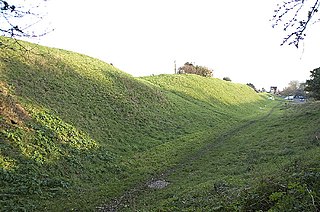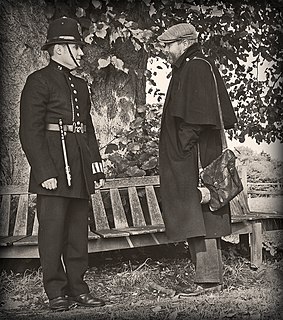
In England and Wales, watch committees were the local government bodies which oversaw policing from 1835 until, in some areas, 1968.

In England and Wales, watch committees were the local government bodies which oversaw policing from 1835 until, in some areas, 1968.
The Municipal Corporations Act 1835 required each borough to establish a "watch committee" and to appoint constables to 'preserve the peace'.
From 1889 counties switched to using "standing joint committees" which also had magistrates among their members. For police forces working within a single borough, watch committees were retained.
The Police Act 1964 replaced both sets of bodies with police authorities, comprising two-thirds elected members of county or borough councils, and one-third magistrates.
A police authority in the United Kingdom is a public authority that is responsible for overseeing the operations of a police force. The nature and composition of police authorities has varied over time, and there are now just four dedicated "police authorities" in the United Kingdom, although the term can refer to various similar successor bodies.
Municipal boroughs were a type of local government district which existed in England and Wales between 1835 and 1974, in Northern Ireland from 1840 to 1973 and in the Republic of Ireland from 1840 to 2002. Broadly similar structures existed in Scotland from 1833 to 1975 with the reform of royal burghs and creation of police burghs.

Devon and Cornwall Police is the territorial police force responsible for policing the counties of Devon and Cornwall, including the unitary authority areas of Plymouth, Torbay and the Isles of Scilly.

The Municipal Corporations Act 1835, sometimes known as the Municipal Reform Act, was an Act of the Parliament of the United Kingdom that reformed local government in the incorporated boroughs of England and Wales. The legislation was part of the reform programme of the Whigs and followed the Reform Act 1832, which had abolished most of the rotten boroughs for parliamentary purposes.

The Local Government Act 1888 was an Act of the Parliament of the United Kingdom, which established county councils and county borough councils in England and Wales. It came into effect on 1 April 1889, except for the County of London, which came into existence on 21 March at the request of the London County Council.
A police burgh was a Scottish burgh which had adopted a “police system” for governing the town. They existed from 1833 to 1975.

The County Police Act 1839 was an Act of the Parliament of the United Kingdom. It was one of the Police Acts 1839 to 1893. The Act enabled Justices of the Peace in England and Wales to establish police forces in their counties. The Act was not compulsory, and constabularies were only established in 25 out of 55 counties by 1856, when the County and Borough Police Act 1856 made their provision mandatory.

Salford was, from 1844 to 1974, a local government district in the northwest of England, coterminate with Salford. It was granted city status in 1926.

The County Borough of Leeds, and its predecessor, the Municipal Borough of Leeds, was a local government district in the West Riding of Yorkshire, England, from 1835 to 1974. Its origin was the ancient borough of Leeds, which was reformed by the Municipal Corporations Act 1835. In 1889, when West Riding County Council was formed, Leeds became a county borough outside the administrative county of the West Riding; and in 1893 the borough gained city status. The borough was extended a number of times, expanding from 21,593 acres (8,738 ha) in 1911 to 40,612 acres (16,435 ha) in 1961; adding in stages the former area of Roundhay, Seacroft, Shadwell and Middleton parishes and gaining other parts of adjacent districts. In 1971 Leeds was the fifth largest county borough by population in England. The county borough was abolished in 1974 and replaced with the larger City of Leeds, a metropolitan district of West Yorkshire.

Stockport County Borough was created by the Municipal Corporations Act 1835 when the existing Borough of Stockport was reformed as a municipal borough. Until 1835 the town was governed by a charter dating from circa 1220 granted by Ranulph de Blondeville, 4th Earl of Chester. The municipal borough consisted of parts of Cheshire, namely the township of Stockport and the neighbouring areas of Edgeley and Portwood and part of Heaton Norris in Lancashire.

The Police Act 1964 was an Act of the Parliament of the United Kingdom that updated the legislation governing police forces in England and Wales, constituted new police authorities, gave the Home Secretary new powers to supervise local constabularies, and allowed for the amalgamation of existing forces into more efficient units.

The ancient boroughs were a historic unit of lower-tier local government in England and Wales. The ancient boroughs covered only important towns and were established by charters granted at different times by the monarchy. Their history is largely concerned with the origin of such towns and how they gained the right of self-government. Ancient boroughs were reformed by the Municipal Corporations Act 1835, which introduced directly elected corporations and allowed the incorporation of new industrial towns. Municipal boroughs ceased to be used for the purposes of local government in 1974, with borough status retained as an honorific title granted by the Crown.
The city of Leicester in England was policed independently until 1 April 1967 when its police force was merged with the Leicestershire and Rutland Constabulary to form the Leicester and Rutland Constabulary.
The Belfast Borough Police was the police force for Belfast from 1800 to 1865, when it was abolished and replaced by the Royal Irish Constabulary (RIC). Its members, nicknamed the Bulkies, had authority within the Belfast Police District.
The Royal Commission on the Corporation of the City of London was a Royal Commission, established in 1853, which considered the local government arrangements of the City of London and the surrounding metropolitan area.

The history of law enforcement in the United Kingdom charts the development of law enforcement in the United Kingdom.

Carlisle was, from 1835 to 1974, a local government district in the northwest of England, coterminate with Carlisle. In 1835, following the Municipal Corporations Act 1835, Carlisle was constituted a municipal borough of Cumberland, but was promoted to county borough status in 1914, within its boundaries taking over the functions of Cumberland County Council. The district was abolished on 31 March 1974 by the Local Government Act 1972.
Liverpool Parks Police was a police force maintained by the Corporation of Liverpool to police the parks and open spaces owned by the city. The first record of "park constables" in Liverpool is from 1832, although members of the force were not sworn in as constables in their own right until 1882. The force was disbanded in 1972.
Walsall Borough Police was a police force in the Borough of Walsall, then in Staffordshire, in England, from 1832–1966.
St Ives Borough Police was the borough police force for the town of St Ives, Cornwall, from 1836 to 1889. It was established following the passage of the Municipal Corporations Act 1835. The force was unique in that it only boasted a single constable at any one time throughout its entire existence.